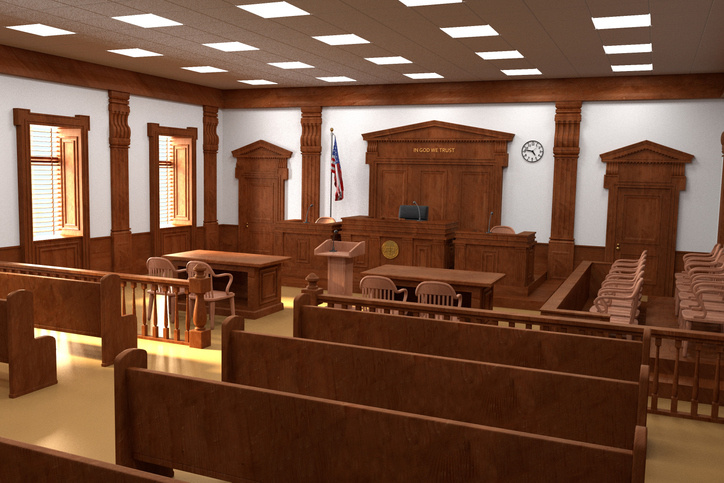Many people expect a jury trial will look like what they see on T.V. In reality, a jury trial is a complex process with many steps. This article presents an overview of generally what to expect from when you set your case for a criminal jury trial through when you get the verdict.
Step One: Setting your case for trial
Once you have plead not-guilty, the Court must hear your case within six months. Depending on the complexity of your case, it could be set for anywhere from one-day to multiple weeks of trial. The Court will enter an order containing important deadlines regarding disclosure of information prior to trial. The Prosecution is required to let you know about any witnesses it plans to call, as well as evidence they are planning to present. At the time you set your case for trial, you might also pick a date for a motions hearing.
Step Two: Motions Hearing
A motions hearing gives the Court an opportunity to hear any evidentiary issues which might influence or dictate the course of the trial. For example, a police officer must have probable cause to arrest you. If the police officer did not have probable cause to arrest you, then everything that occurred after the arrest is inadmissible. Another common issue presented at motions hearing concerns any statements made by you. If any statements were obtained in violation of your Constitutional rights, then the Court may choose to suppress those statements. During the motions hearing, your attorney will have the opportunity to cross-examine the police officer or officers on these evidentiary issues.
The results of a motions hearing can have major evidentiary impacts on your trial. You can also request a transcript of the motions hearing. If witnesses’ testimony changes at trial from the motions hearing, you can use the motions hearing transcript to question their credibility.
Step Three: Pre-trial Conference
The pre-trial conference (“PTC”) generally occurs one-week before your trial. The PTC is an opportunity to address last minute issues before trial. Often, both sides have submitted “motions in limine” to address legal and evidentiary issues in advance. If the Court has not already ruled on the motions in limine, it may use the PTC as an opportunity to hear argument and make findings.
Additionally, the Court will expect both parties to have submitted proposed jury instructions. Jury instructions guide the jurors on the issues and the law and are therefore extremely important.
Step Four: Jury Selection
On the first day of trial, you will begin by selecting a jury. The jury selection process is called “voir dire.” The number of jurors depends on the level of crime and jury selection can vary by judge. However, the idea is to start with a large group of people and narrow down that group until you have the correct number of jurors. Both sides are able to ask questions of prospective jurors.
There are two ways a potential juror can be dismissed. One is “for cause,” meaning there is a reason a particular juror is barred from serving. One example would be if the juror is employed by the Defendant.
The second way a juror can be dismissed is by peremptory challenge. The Prosecution and Defense each get a certain number of peremptory challenges depending on the jury size. Thus, each side has the opportunity to dismiss a certain number of jurors for any reason at all.
Step Five: Opening Statements
Each side gets the chance to present an opening statement. The purpose of the opening statement is to let the jurors know what the case is about. Some studies suggest that jurors make up their minds about a case during opening statements, so it is important to present a clear picture or your case.
Step Six: Presentation of Evidence
The Prosecution bears the burden of proof in a criminal case and therefore presents its evidence first. The Prosecution must prove the case beyond a reasonable doubt. The Defense is not required to put on any evidence whatsoever, though often the Defense does choose to present evidence. Each side has the opportunity to present evidence in the form of witness testimony and the form of physical evidence like documents or video.
Step Seven: Closing Arguments
After both sides have presented all the evidence, the judge will read the jury instructions to the jurors. Then, the lawyers argue why the jury should reach a particular verdict. This is the opportunity to present the law and argue why the facts do or do not support a particular finding.
Step Eight: Jury Deliberation
Once closing arguments are complete, the jury begins its deliberation. Sometimes, the jury will have questions during their deliberation. These questions get submitted to the bailiff, who provides them to the judge. The judge and lawyers review the question to see whether it can be answered. The length of jury deliberation varies greatly from case to case. It can take a jury minutes to days to return a verdict.
Step Nine: Verdict
Once the jury has completed their deliberation, everyone returns to the court room for the reading of the jury verdict. Typically, the judge will read the verdict and ask the defendant to stand as the verdict is being read.
Step Ten: Sentencing
If the jury finds you guilty of any of the charged offenses, you the judge may sentence you immediately. For more serious charges, the judge will typically schedule sentencing for a later date. If you disagree with the jury’s verdict, you may consider filing an appeal.
Taking a case to trial is time-consuming and complex. The criminal defense attorneys at Kalamaya | Goscha have extensive trial experience. Should you find yourself charged with a crime, our team will expertly guide you through the process.

